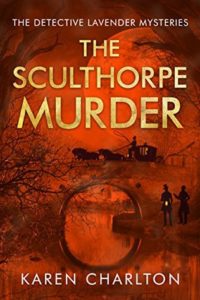Book Review: The Sculthorpe Murder by Karen Charlton
Disclaimer: I received a Kindle download of this book as a Goodreads giveaway for the purpose of writing this review. No other compensation was offered or requested.
The year is 1810, and Bow Street Runner Detective Stephen Lavender has been called from his native London to Northamptonshire. It seems that an elderly man, William Sculthorpe, has been robbed and murdered. The most likely suspects are a gang known as the Panthers, whom the local authorities have been unable to put their hands upon. But when Lavender and his friend Horse Constable Ned Woods investigate at the request of a wealthy noblewoman, they find clues that suggest otherwise. Most notably, the testimony of Sculthorpe’s son Billy who actually saw the murderers. But he’s an unreliable witness who talks about “dark elves”, so has been mostly ignored.
This is the third Detective Lavender mystery, and I have not read the previous volumes. According to the author’s notes, her main character is loosely based on the life and activities of a real Stephen Lavender, who was an officer of the Bow Street magistrates. Likewise, this book’s case is based on one Mr. Lavender actually solved, though Ms. Charlton took liberties with even the bare bones account provided by historical records.
Billy Sculthorpe has Down syndrome (called “cretinism” in the story because Dr. Down hadn’t even been born yet, let alone started studying the condition.) Lavender quickly realizes that despite his moderate mental disability, and a vivid imagination fed by spooky stories his recently deceased Mum had told him, Billy is a talented artist and has a good memory. Billy’s testimony leads the detectives to discover clues about William Sculthorpe’s actual past and other possible motivations for his murder.
The sleepy village of Middleton and its surroundings turn out to have many dark secrets that get turned up by the murder investigation, multiplying the number of suspects. There are even ties back to London, which allows Lavender’s love interest Magdalena and other city-bound characters to make an appearance. Meanwhile, Constable Woods finds his own past catching up with him.
As often happens with historical mysteries, Stephen Lavender as the protagonist is perhaps just a little too enlightened for the times he’s living in, believing in religious tolerance and treating the women in his life with respect for their intelligence and opinions. Woods is a bit more believable as a person of the early Nineteenth Century, but not so much so as to make him unsympathetic.
I found the solution to the mystery satisfying; genre-savvy readers will spot one of the murderers very early on, and clues as to how it was done are abundant. Much of the last part of the book is Detective Lavender negotiating just how many of the crimes he’s uncovered must come to light, and which must face justice of a more subtle sort.
Possible trigger issues: There’s some discussion of spousal abuse and animal abuse in the backstory, including the fact that it was even more difficult to get out of an abusive marriage in the Eighteenth Century than it is today. There are some slurs hurled by less sympathetic characters towards Billy because of his condition, a bit of slut-shaming, and anti-Catholic slurs.
Recommended to fans of the historical mystery sub-genre.

